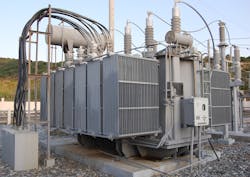Article 450, Part II provides the installation requirements for transformers. There are actually several sets of requirements, each of which pertains to a specific transformer configuration. Not mentioned here are the mechanical requirements (e.g., type and size of mounting channel) or any seismic requirements (those exist in separate standards). And some of the installation requirements are in Part I because they apply to all transformers generally.
Highlights from Part II:
- Dry-type transformers installed indoors and not over 112.5 kVA must be at least 12 in. away from combustible materials [450.21(A)].
- Dry-type transformers installed indoors and over 112.5 kVA must be installed in a transformer room of fire-resistant construction having a minimum fire rating of one hour [450.21(B)].
- Dry-type transformers installed indoors and over 35,000V must be installed in a vault complying with 450, Part III [450.21(C)].
- Less-flammable liquid-insulated transformers installed indoors must meet one of the three conditions in 450.23(A). For example, if the transformer is rated under 35,000V, there are both an automatic fire extinguisher system and a liquid confinement area.
- Less-flammable liquid-insulated transformers installed indoors must meet one of the two conditions in 450.23(B). For example, it meets the same installation requirements as oil-insulated transformers per Sec. 450.27.
- Non-flammable fluid-insulated transformers must be installed in a vault if rated over 35,000V [450.24].
- Askarel-insulated transformers installed indoors and rated over 25 kVA must have a pressure-relief vent [450.25].
- Oil-insulated transformers installed indoors must be in a vault [450.26]. Six Exceptions follow this requirement.
- Oil-insulated transformers installed outdoors must be installed with safeguards to prevent fires originating in the transformer from spreading to buildings, fire escapes, and (among other things) door openings. Four such safeguards are enumerated, for example fire-resistant barriers can be used [450.27].
- If you modify an installed transformer such that it changes from its old configuration to a new one, it does not get grandfathered in. You must also make it conform to the requirements for the new configuration [450.28].
These highlights don’t include all of the requirements for all of the transformer configurations mentioned.
About the Author

Mark Lamendola
Mark is an expert in maintenance management, having racked up an impressive track record during his time working in the field. He also has extensive knowledge of, and practical expertise with, the National Electrical Code (NEC). Through his consulting business, he provides articles and training materials on electrical topics, specializing in making difficult subjects easy to understand and focusing on the practical aspects of electrical work.
Prior to starting his own business, Mark served as the Technical Editor on EC&M for six years, worked three years in nuclear maintenance, six years as a contract project engineer/project manager, three years as a systems engineer, and three years in plant maintenance management.
Mark earned an AAS degree from Rock Valley College, a BSEET from Columbia Pacific University, and an MBA from Lake Erie College. He’s also completed several related certifications over the years and even was formerly licensed as a Master Electrician. He is a Senior Member of the IEEE and past Chairman of the Kansas City Chapters of both the IEEE and the IEEE Computer Society. Mark also served as the program director for, a board member of, and webmaster of, the Midwest Chapter of the 7x24 Exchange. He has also held memberships with the following organizations: NETA, NFPA, International Association of Webmasters, and Institute of Certified Professional Managers.
